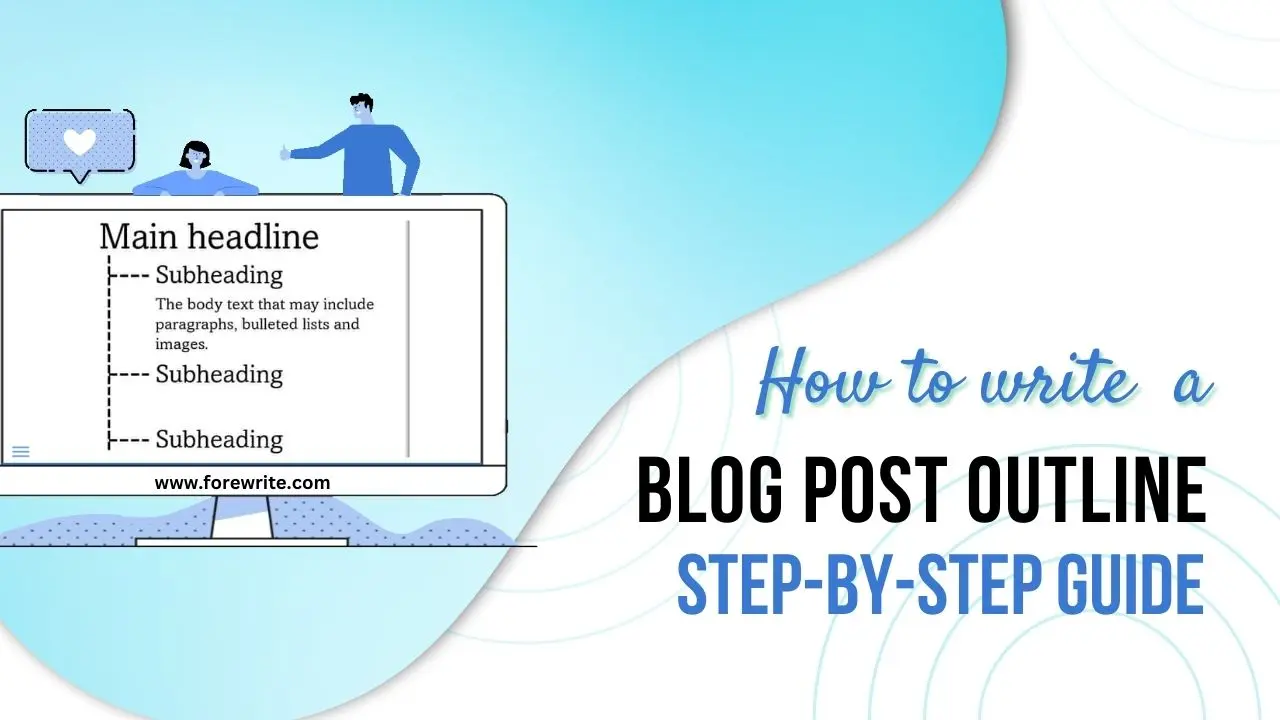Writing an engaging blog post is no mean feat. It requires meticulous planning, a deep understanding of your audience, and the ability to weave words into a captivating narrative. But before you dive into the writing process, there’s an important step you should never skip: creating a blog post outline.
In this comprehensive guide, we’ll take you through the steps of crafting a blog post outline that organizes your thoughts, helps you stay on track, and maintains focus throughout your writing journey.
Unraveling the Concept of a Blog Post Outline
A blog post outline serves as your roadmap to successful blog writing. It’s a strategic document that helps you organize your thoughts, streamline your ideas, and create a logical flow for your blog post.
An effective blog post outline includes:
- Your core topic or subject matter
- Your unique perspective or angle on that topic
- A structured layout of your blog post with main points and sub-points
Ultimately, a blog post outline aims to provide a clear direction for your writing and ensure coherence and relevance in your content.
The Power of a Blog Post Outline
Crafting a blog post outline isn’t just an extra step in your writing process—it’s an integral part of content creation that offers numerous benefits:
- Beat Writer’s Block: An outline provides a clear starting point, reducing the intimidation of the blank page.
- Organize Your Thoughts: Outlines help you structure your ideas, ensuring you cover all relevant points and maintain a logical flow of information.
- Improve Efficiency: With a detailed outline, you can write more effectively and efficiently, saving you time and energy.
- Enhance Coherence: A well-structured outline guides you in creating a coherent and well-organized blog post, enhancing readability.
- Ensure Consistency: Outlines ensure you stay on track, maintaining consistency in your content and preventing irrelevant digressions.
The Ideal Timing for Crafting a Blog Post Outline
The best time to create a blog post outline is right after you’ve completed your keyword research and before you start writing your blog post. This timing allows you to naturally incorporate your keywords into your outline, ensuring SEO-friendly content from the start.
Creating an outline also aids in defining your blog post structure and identifying the key points you need to cover, making the writing process smoother and more efficient.
Step-by-Step Guide to Crafting an Efficient Blog Post Outline
Creating a blog post outline doesn’t have to be a daunting task. Here’s a step-by-step guide to help you navigate the process smoothly:
1. Identify Your Core Topic
Start by defining the main topic of your blog post. This should be a specific subject that you want to explore in your blog. Ask fundamental questions like ‘what’, ‘where’, ‘why’, ‘when’, and ‘how’ to narrow down your topic and make it more focused.
2. Decide Your Unique Angle
Your angle is what sets your blog post apart from the rest. It’s your unique perspective on the topic that adds value and uniqueness to your content. Think about your personal experiences, expertise, or unique insights related to the topic that you can bring to the table.
3. Structure Your Main Points
Next, outline the main points you want to convey in your blog post. These should be the key arguments or ideas that support your angle. Each main point will be a section in your blog post, typically marked with H2 headers.
4. Detail Your Sub-Points
Under each main point, list out the sub-points or specific details you plan to cover. These could be supporting arguments, examples, data, or insights that substantiate your main points. These sub-points would typically be marked with H3 headers under each main point.
5. Craft Your Introduction and Conclusion
Your introduction should effectively introduce your topic and angle, and hook your readers. Your conclusion should wrap up your main points and leave readers with a final thought or call to action. While it’s often easier to write these sections after you complete the main body of your blog post, outlining them beforehand can provide a clear direction for your writing.
Expanding Your Outline: Delving into the Sub-Points
Once you have your main points and sub-points outlined, it’s time to delve deeper.
For each sub-point, jot down specific ideas or information you want to include. This could be a brief explanation of an argument, examples, expert quotes, or data you plan to cite.
This detailed outline will serve as your guide when you start writing, helping you maintain a logical flow and ensure that you cover all necessary points.
Finetuning Your Blog Post Outline: Checking for Coherence and Flow
After you’ve filled out your outline, take a moment to review it for coherence and flow. Make sure your ideas are logically arranged and that each point smoothly transitions to the next.
At this stage, you might find it helpful to rearrange some sections or refine your points for clarity. Remember, your outline is not set in stone. Feel free to tweak it as needed to ensure a coherent and compelling blog post.
Leveraging the Power of Data in Your Outline
An outline isn’t just about structuring your ideas—it’s also about building authority and credibility for your blog post. Including specific data or research findings in your outline can bolster your arguments and add weight to your content.
As you develop your outline, look for relevant data, studies, or expert opinions that you can incorporate into your sub-points. This will not only enhance the credibility of your blog post but also provide valuable information to your readers.
Crafting Engaging Titles and Headings
While your main focus should be on the content of your blog post, don’t underestimate the importance of engaging titles and headings. These elements can draw readers in, guide them through your content, and make your blog post more scannable.
As you finalize your outline, spend some time crafting compelling titles and headings for each section. A well-thought-out title or heading can significantly enhance the readability and engagement of your blog post.
Finalizing Your Outline: Seeking Feedback
Before you dive into writing, it’s a good idea to seek feedback on your outline. Whether it’s from a colleague, editor, or friend, getting a fresh perspective can help you identify any gaps, inconsistencies, or areas for improvement in your outline.
With constructive feedback, you can refine your outline to ensure a smooth and efficient writing process.
Diving into the Writing Process
Armed with a well-crafted outline, you’re now ready to dive into the writing process. Your outline will serve as your guide, helping you maintain focus, coherence, and logical flow as you bring your blog post to life.
Remember, your outline is your roadmap, but it’s not a rigid framework. Feel free to adapt it as you write, add new ideas, refine your points, or re-arrange sections as needed.
Blog Post Outline Template: A Handy Tool for Your Writing Process
To help you get started with crafting your blog post outlines, here’s a simple template you can use:
- Introduction
- Overview of the topic and angle
- Hook to engage readers
- Main Point 1
- Sub-point 1
- Sub-point 2
- Sub-point 3
- Main Point 2
- Sub-point 1
- Sub-point 2
- Sub-point 3
- Main Point 3
- Sub-point 1
- Sub-point 2
- Sub-point 3
- Conclusion
- Summary of main points
- Final thoughts or call to action
Feel free to customize this template to fit your needs and writing style.
Wrapping Up: The Power of a Well-Crafted Blog Post Outline
Creating a blog post outline may seem like an extra step in your writing process, but it’s a step that can significantly enhance the quality of your content. A well-crafted outline can streamline your writing process, improve the coherence of your blog post, and ensure that your content resonates with your readers.
So the next time you’re tasked with writing a blog post, take a moment to craft an outline. You’ll be amazed at how much easier and more efficient your writing process becomes.




